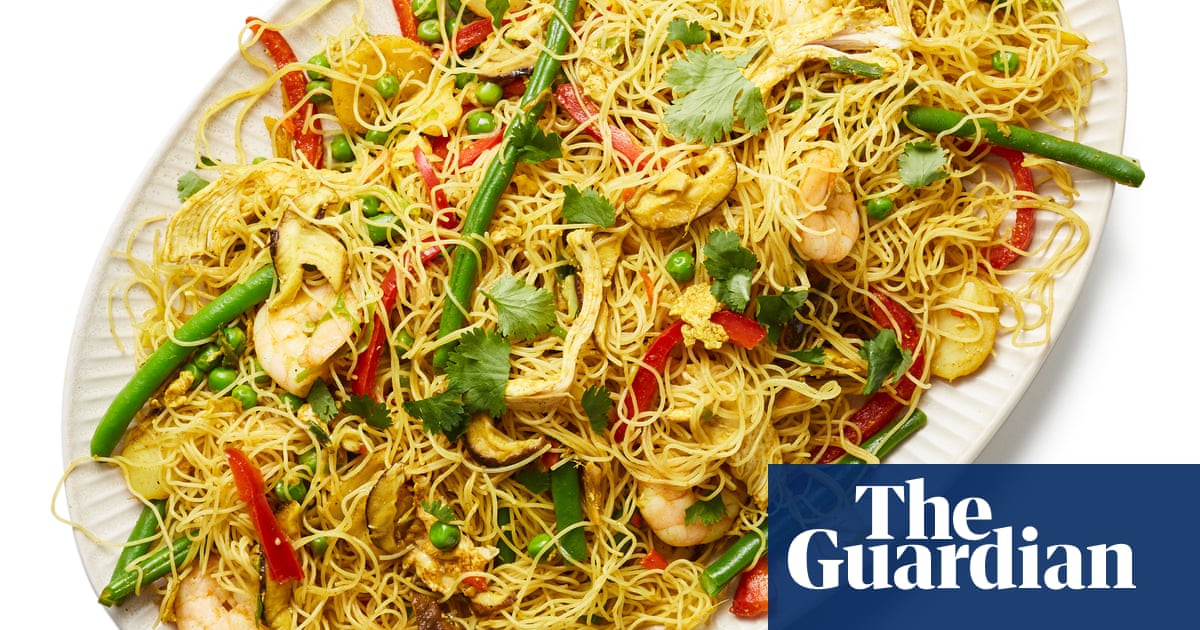The secret of this Cantonese favourite, apparently largely unknown in Singapore itself, is, as so often with noodles, speed: if you’ve only thus far enjoyed it after it’s spent 20 minutes on the back of a scooter, eating it hot straight from the wok, rather than clumped together in a plastic takeaway container, will be a revelation. It’s easily made meat-free and gluten-free, too.
------Advertisement-----
Prep 20 min
Cook 6 min
Serves 2
125g rice vermicelli
1 handful green beans
2 garlic cloves
4cm piece root ginger
1 bird’s eye or other hot chilli
2 spring onions
2½ tsp curry powder
6 water chestnuts
5 shiitake mushrooms
½ red pepper
1 handful peas – frozen are fine
3 tbsp gluten-free soy sauce
2 tbsp rice wine, or dry sherry
A pinch of sugar
50g char siu pork, or cooked chicken
1 egg
A splash of sesame oil
50g prawns, defrosted if necessary
2 tbsp peanut oil, or other neutral oil
1 handful chopped coriander, to serve (optional)
------Advertisement-----
1 Get organised
Because it comes together so quickly at the end, you need to have all your ingredients prepared before you fire up the wok (you could use a large frying pan instead, but a wok will make life easier), otherwise you’ll end up with a gluey, overcooked mess. I’d suggest reading the recipe right through while you boil the kettle for the noodles.

2 Blanch the noodles, then drain
Put the vermicelli in a heatproof bowl and cover with boiling water. Leave for 30-45 seconds, until softened, but not totally soft, then drain and leave to dry in a sieve or colander while you prepare the other ingredients; toss the noodles occasionally, to ensure they don’t clump together. Top and tail the beans.
------Advertisement-----
3 Prep the garlic, ginger and chilli

Peel and crush the garlic and ginger, and put them in a small bowl. Trim and finely chop the chilli (remove the seeds, if you’re sensitive to heat, or add another chilli, if you enjoy it), and add to the bowl. Trim the spring onions, slice both white and green parts diagonally, then put these in the bowl and add half the curry powder.
4 Prep the remaining veg

Drain and slice the water chestnuts, if necessary, trim and finely slice the mushrooms and pepper, and put both in a bowl with the peas. Substitute other veg to suit your tastes here, bearing in mind that you might need to blanch crunchier ones such as broccoli or carrot along with the beans in the next step, or to fully cook things such as pumpkin first.
5 Blanch the green beans
Blanch the beans in a small pan of boiling water for a minute, then drain and add to the other vegetables. In a second bowl, toss the noodles with the remaining teaspoon and a quarter of curry powder, soy sauce, rice wine or sherry, and a pinch of sugar, until well coated. Put both bowls near the hob.
6 Chop any meat

You don’t need to use meat, but Singapore noodles are a great way to stretch leftovers. Shred or cut any meat you’re using into chunks and put it next to the two bowls. (You could even make some char siu pork the day before, keeping back a little for this purpose – chef Jeremy Pang has .)
7 Crack the egg and get any seafood ready

Crack the egg into a cup and beat with a pinch of salt and a dash of sesame oil. Put this near the hob, along with the prawns – you can use raw or cooked (raw will need to go in the wok a little before the meat, to start cooking), or another seafood such as chunks of crabmeat or drained tinned mussels, if you prefer.
8 Start cooking

Put the oil in a wok set over a high heat until smoking, then add the garlic and ginger mixture. Stir-fry for about 30 seconds, until fragrant, then tip in all the vegetables and stir-fry for a couple of minutes. Push all the veg to one side of the wok, tip the beaten egg into the other side, leave it to cook undisturbed, until almost set, then scramble into the vegetables.

9 Finishing touches
Add the meat and prawns to the pan, then tip in the noodles and toss everything together for a couple of minutes (tongs are useful here), so all the various ingredients are well distributed among the noodles.

Heap on to a serving plate, top with chopped coriander, if using, and serve immediately.
